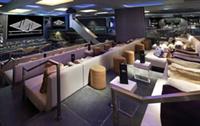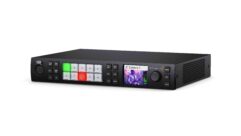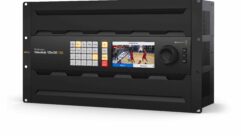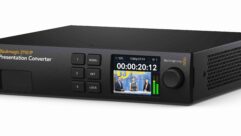

You Can Get There From Here
The challenge for any good signal distribution system is to send a variety of video signals to an equal variety of display devices.
The challenge for any good signal distribution system is to send a variety of video signals to an equal variety of display devices. And to meet the challenge, there’s a bewildering array of devices. And while you might regard distribution as a job for installers in malls, casinos, stadiums, and other large venues, it can also be necessary in small educational and corporate settings where flexibility in switching between content sources to one or two display devices–say, a monitor and a projector–is called for.
Even though it was open less than a year, Jay-Z’s 40/40 Club in Las Vegas was an AV playground. JVN Systems opted for a video distribution solution that utilized Cat-5 wiring and a Magenta Mondo Switch (see sidebar).
Credit: Nicholas Foresta
The question becomes, with all the options at your disposal, with all the permutations of video distribution applications, what system configuration is right from you? More pointedly, what system will get your video signals from point A to points B, C, and D without busting your and your client’s budget?
Three main variables that determine a distribution architecture are wiring, the content to be displayed, and the connectors on input and output devices. When you address these variables, basing your decisions on specific questions, it will lead you to the right system.
Category-5 or Something Else?
The first variable, wiring, is probably the most important. When the time comes, you can usually deal with content and I/Os by adding cards and adapters to make almost any content source talk to any display. Understanding how you’ll connect your endpoints, though, will determine a lot.
But first you have to ask if you even need video signal distribution. If your only desire is to play a looping video or data display, connecting a DVD player or streaming-video player from a vendor such as Roku directly to a screen might be adequate. You won’t have as much flexibility in managing the content, and such devices often have hard drives and other moving parts that can negatively impact reliability. So it’s important to ask which displays must be able to show live or frequently varied content, and what your requirements are for image quality and uptime. The answers will drive the decision on which displays can get by with locally stored video.
At distances exceeding 100 feet, the choice of well-heeled or security-conscious customers would normally be fiber-optic cabling, but for cost reasons, most people opt for the unshielded twisted-pair (UTP) copper wiring of Category-5 network cables. Coaxial cable is cheaper still, but at such distances, it might need a peaking amplifier or long-distance line driver to maintain signal strength.
Paul Hand, product manager for AMX’s AutoPatch group, says most installations covering shorter distances use coax because of its track record in AV, but economics and improved technology make Cat-5 the choice for nearly anything but the smallest video distribution systems.
“[Coax] is so much more cost-effective and so proven. It’s been used forever and people know how to deal with it,” Hand says. “Cat-5 is a cruddy way of sending high-resolution video. It’s a poor medium. But the industry has come up with great devices–the transmitters and receivers–to overcome that.”
With Cat-5, the idea is to use a building’s existing data wiring, or if new cabling is unavoidable, to have it be the cheapest possible. Special equipment is required to convert AV signals for transmission over UTP. Near the video source is a transmitter, and at the other end of the wire, a receiver, typically one per display, though some are dual-display. Sometimes a distribution hub is needed to replicate and transmit signals to additional devices.
Performance can certainly be comparable to coax, and because of its smaller circumference, UTP can be easier to thread through conduit and might be a better option in older buildings, which might lack conduits and have few places to conceal coax. UTP terminates in a common RJ45 connector.
Still, when considering wiring, be aware of Cat-5’s other characteristics. Especially at long distances, twisted-pair cable is prone to skew: variations in the lengths of each pair of wires that can cause a horizontal misalignment in the red, green, and blue colors on the screen, compromising image quality. There are devices designed to compensate, but many support fixed lengths. Pick the wrong length, and you might have to add more such devices at greater expense than if you had picked longer, or variable, lengths in the first place.
You Can Get There From Here
The challenge for any good signal distribution system is to send a variety of video signals to an equal variety of display devices.
At long distances, UTP cabling is prone to skew. Signal distribution products like AMX’s CatPro receivers/transmitters have skew compensation built in.
Nature of the Content?
At long distances, UTP cabling is prone to skew. Signal distribution products like AMX’s CatPro receivers/transmitters have skew compensation built in.
Beyond wiring infrastructure, the basic questions you need to ask are the same as for any communication medium. For instance, is your audience mobile (travelers in an airport, for example) or captive (students in a classroom, or executives in a boardroom)? The answers to questions like these can determine the size, number, and location of displays, and the types of content they must show.
The answers will also determine performance requirements of the distribution system. For instance, what about the content delivery might affect the degree of latency that is acceptable between displays showing the same content? A sub-second lag can annoy fans at a soccer stadium who can see multiple displays simultaneously, but go unnoticed to museum visitors stopping at the occasional interactive touch panel.
Excess latency is also often undesirable in security applications. Latency concerns will tend to lead designs away from streaming-video, image compression, and other digital technologies and toward analog–and the video signal distribution decisions that go with it.
How Much Distribution?
The next critical question to ask is how many components you plan to have on each side of the input/output equation: point-to-point, point-to-multipoint, and multipoint-to-multipoint. And when you’re asking that, determine what AV connector standards are on either end of the distributed signal, and how many of each?
Some integrators swear by a modular approach that lets you swap cards in and out for particular connectors as you need them. In any case, format agility is key, says Chris Miller, chief scientist at Magenta Research.
When you have multiple transmitters and receivers, as AV pros know, matrix switchers become necessary. For example, Magenta’s Mondo Matrix is a popular choice for replacing 5-BNC connectors.
“In the 5-BNC world, there’s really no way to manage the cable boxes in an economical way,” Miller says. “Even going 100 feet becomes a dicey proposition. There will be some video loss. Artifacting will be an issue.”
Magenta also has a distribution hub called the 9D that will accept a single UTP and send it along to nine UTP outputs, each of which can be a receiver or a display, Miller says. Other Magenta devices, the T4 and T5, take a single VGA signal and output it to four or five UTP cables. Receivers can then be daisy-chained up to 12 receivers, he says.
Generally, you can use matrix switchers and distribution hubs as building blocks to extend video great distances. Unfortunately, you cannot mix and match equipment from different vendors, as each has it own way of converting and formatting signals.
How Will the Displays Factor In?
The next critical element is the number and types of displays you plan to have, their distance from video sources, and whether any are clustered together. Miller says the distance to display can also affect the choice of switches, as can the mix of video sources.
Your ability to achieve the resolutions you need at certain distances can depend on which vendor you choose. Each makes different claims about how far it can support HD resolutions, and which resolutions within the HD standard.
Lee Dodson, vice president of marketing at Extron, maker of Mini Twisted Pair (MTP) and Fiber Matrix devices, says resolution times refresh rate is a good metric to use. “The higher that is, the shorter the distance you’ll be able to go down a cable and achieve good results,” Dodson says. He recommends taking vendor distance claims with a grain of salt, adding Extron won’t make such claims. “It’s not a cut-and-dried scenario,” he says.
Matrix switchers, by their very nature, bring centralized control to AV systems that might have been decentralized before. “Having a centralized signal-management system greatly reduces the number of sources and provides a single point of control for audio/video management,” Hand says. “This also holds true when we begin adding in additional functionality,” such as volume control on audio output feeds. “I can now have a single point (the matrix switcher) where I can adjust line level audio.”
But you might need to consider the level of control over displays that your equipment can provide. You might need to prove to advertisers that a screen was functioning and showing their content, or turn up the brightness on screens that face windows. The ability simply to turn displays off is an important feature in these energy-conscious times. Typically, outfitting your video signal rack with RS-232 serial connections will do the trick.
If downtime is unacceptable–a typical requirement of military command-and-control centers, but not so with the information displays in the hallways of casino hotels–build in redundancy and avoid having a single point of failure that can take the entire system down. One approach is to have extra channels that let you switch over a content input port when, say, an output port fails. Magenta switchers also have the ability to be set up to monitor the output ports going to display devices to confirm they are operational, Miller says.
Digital or Analog?
As of today, video distribution is still mostly an analog thing. Only a small portion of video-distribution products are digital, though that is gradually changing as digital standards such as DVI become more popular. So besides analog video standards such as S-video and RGB, UTP transmission equipment can handle digital video formats such as DVI, HDMI, digital audio, and control signals.
Cat-5 Video with Class
It was great while it lasted. When the 40/40 Club in Las Vegas opened on New Year’s Eve 2007, it was a high-profile AV project that absolutely had to be finished on time. That night, the club, co-owned by music mogul Jay-Z, hosted a star-studded bash that coincided with the grand opening of the Palazzo Hotel Casino where it was located. (The Las Vegas Sands Corp. bought back the club space last fall to convert it to a race and sports book.)
JVN Systems of Deer Park, N.Y., handled the club’s AV integration and went with a video distribution system built around a Magenta Research Mondo 32×96 Switch.
“We saved the client money and time by eliminating the traditional switching equipment,” says Vito Randazzo of JVN Systems. “This enabled us to purchase and pull Cat-5 to the displays, which saved in cable cost, shipping, and termination labor.”
The switch employed Composite inputs and Cat-5 outputs to the club’s 25 plasma 720p displays. The integrators installed 56 Magenta MultiView AK500 Cat-5 video receivers with Simplex RS-232, plus a handful of other MultiView receivers and transmitters.
“Without the system, we would not have been able to meet the budget or the client’s deadline,” says Randazzo. “This saved tens of thousands of dollars and countless man hours.”
DVI and HDMI continue to emerge as standards, and you should have flexibility to accommodate them in the future, even if you aren’t using them now. But their high-bandwidth digital content protection (HDCP) quirks remain a major impediment for most installers.
What’s more, because HDCP is designed to limit the showing of unauthorized content, DVI and HDMI are less relevant to video signal distribution, which is typically employed in the kinds of multiple-display environments in which content creators fear losing their intellectual property. “It’s a very, very tricky protocol,” Miller says. “It’s one reason VGA and RGB continue to thrive.”
This is also true when adding HD content, an increasingly popular option, says Kamran Ahmed, Magenta’s director of international sales. “To do 1080p over 2,000 feet of Cat-5 cable–that capability doesn’t exist,” Ahmed says. “You can get hi-def 1080p capability on VGA which is the same as you get on DVI, and there is no quality difference.”
More fundamentally, Dodson questions the value of going all-digital, saying the real test is whether the customer can see the difference. Hybrid approaches are impractical.
“If you break out of being digital at any point from source to destination, you kind of lose the fundamental benefit of being digital in the first place,” he says. What’s more, HDCP requires 100-percent digital transmission, and many businesses show their own material and don’t need copy-protection in the first place.
“Analog is not an inherently bad signal format,” Dodson says. “It’s very mature and very cost effective. It’s quite a robust infrastructure.”
The H.264 standard for streaming video, already well established in the videoconferencing world, will continue to gain in professional AV, says Miller, calling it “an efficient compression algorithm that yields very good results.”
Whatever comes down the pike, it’s clear manufacturers of video signal distribution devices will be ready.










